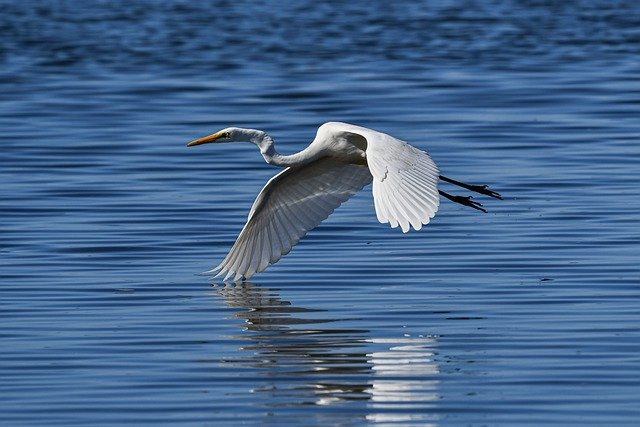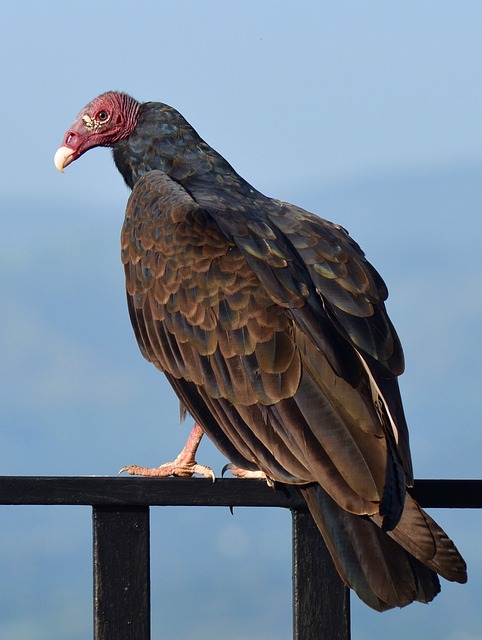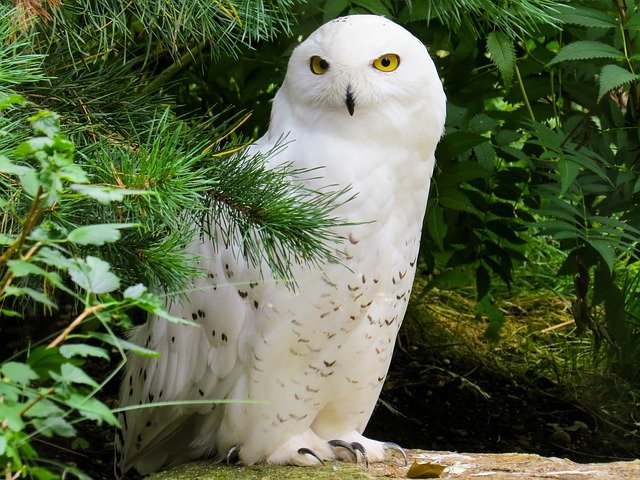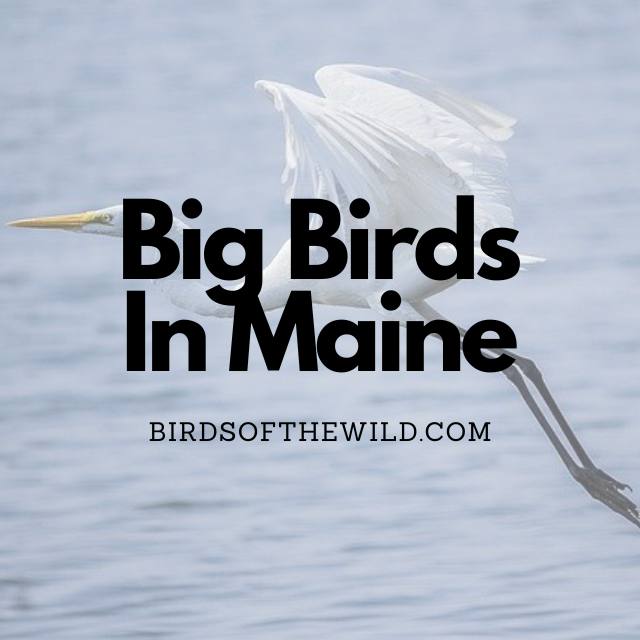In this article I’ll be going over 7 big birds that can be found throughout Maine so continue reading for a more detailed look at each bird below.
- Great Egret
- Great Horned Owl
- Turkey Vulture
- American Herring Gull
- Snowy Owl
- Snowy Egret
- Golden Eagle
7 Big Birds In Maine
1. Great Egret (Ardea Alba)

- Size: 80 – 100cm
- Weight: 0.7 – 1.5kg
- Wingspan: 130 – 170cm
You’ll be able to spot great egrets in the southern region of Maine when they make their migratory passage through the state.
Great egrets are recognised by their extremely long necks, yellow bill, long black legs and mostly white plumage. Both males and females look very similar with the males being generally larger than the females.
Great egrets spend the majority of their time within marshes, ponds, shores and mud flats.
As for what they eat, it includes primarily consume fish along with crustaceans, amphibians, and small mammals. They will also forage around open areas.
Great egrets tend to live for around 15 years in the wild and around 22 years in captivity.
2. Great Horned Owl (Bubo Vrginianus)

- Size: 57 – 63cm
- Weight: 1.4 – 1.5kg
- Wingspan: 1.35 – 1.5m
Great horned owls can be found all across Maine on a year round basis.
These large horned owls are recognised by their brown/gray plumage with their defining feature being the tuft of feather on the top of their head resembling a horn or ear like feature. Male and female great horned owls look relatively the same with the females slightly larger in size.
At night these birds will perch on a branch or a tall building to look around for prey and once the desired prey has been found they will fly towards it with folded wings, grab the prey with their talons piercing through their body and in most cases killing them immediately.
As for what these birds eat it includes smaller prey like rodents, frogs or scorpions. Even other larger predators like geese, ducks, hawks, and smaller owls can be eaten by these carnivorous birds.
Great horned owls are most commonly found in deserts, wetlands, forests, grasslands, backyards, cities and they can also be found in semi-open habitats between the Arctic and the tropics.
As for a great horned owls lifespan, it can be anywhere from 15 -25 years.
3. Turkey Vulture (Cathartes Aura)

- Size: 62 – 81cm
- Weight: 1.5 – 2 kg
- Wingspan: 1.6 – 1.8m
You’ll find turkey vultures across southern Maine in their spring and summer breeding season.
Turkey vultures have a plumage that is mostly brownish/black in color with silver/gray lining on the underside of their wings adding a contrast to their overall appearance. The face is pink/red with elements of black on the head topped of with a pale white beak.
These scavengers are mono-morphic so they do look the same with the only differentiating aspect being their sexual organs.
Turkey vultures are scattered throughout north America where they can be found staying within open and forested habitats where they will also stay within lower elevation mountain ranges.
Carrion is a turkey vultures primary food source but, they do also eat dead reptiles, birds, amphibians and invertebrates. As a whole these vultures do prefer fresher carrion but, like other vultures they can consume the same carcass over several days.
Turkey vultures are known to live for around 16 years in the wild and up to 30 years in captivity.
4. American Herring Gull (Larus Smithsonianus)

- Size: 60 – 67cm
- Weight: 1 – 1.5kg
- Wingspan: 120 – 160cm
You’ll find American herring gulls all across the state of Maine in their breeding spring and summer seasons.
American herring gulls are recognised by their gray wings, black tail feather, white feathers in the remainder of their body, yellow beak and reddish/orange legs. The females are typically a dirty light brown/gray color where it appears as if they’ve had mud sprayed across their feathers.
You’ll find these herring gulls around coasts and inland around rubbish tips, fields, large reservoirs and lakes.
In regards to what these gulls eat, it tends to be carrion, offal, seeds, fruits, young birds, eggs, small mammals, insects and fish.
American herring gulls are know to live for around 30 years on average, with the longest recorded hitting 49 years of age.
5. Snowy Owl (Bubo Scandiacus)

- Size: 52 – 71cm
- Weight: 1.1 – 2kg
- Wingspan: 125 – 164cm
Snowy owls can be found all throughout Maine in their non-breeding fall and winter months.
These owls are recognised by their mostly white plumage with brown dots throughout the body. Females on the other hand are generally less white than the males as the brown spots encompass more of their body.
Snowy owls tend to spend their time within arctic tundra or open grasslands and fields, whilst avoiding forested areas.
As for what they eat, it includes lemmings and a variety of small mammals. Nevertheless, they will still occasionally eat larger mammals like like hares, rats, rabbits, etc.
Snowy owls have been observed to live for around 28 years in captivity and between 10+ years in the wild.
6. Snowy Egret (Egretta Thula)

- Size: 56 – 66cm
- Weight: 350 – 390 grams
- Wingspan: 95 – 105cm
You can spot snowy egrets in southwest Maine in their spring and summer breeding season.
Snowy egrets as their name would suggest are snow white birds with a long neck, black beak, black legs whilst also having a relatively large frame. Besides their sexual organs the only differentiating factors between males and females are that the males are slightly larger.
You’ll find these egrets by mudflats, beaches, and wetlands, but you can also see them forage in wet agricultural fields and along the edges of rivers and lakes.
Snowy egrets eat a variety of foods from fish, insects, crustaceans which includes crabs, crayfish, frogs, snakes, snails, worms, lizards, rodents and more.
These egrets are known to live for around 5 – 6 years in the wild and upwards of 16 years in captivity.
7. Golden Eagle (Aquila Chrysaetos)

- Size: 70 – 82cm
- Weight: 3.7 – 5.3kg
- Wingspan: 190 – 212cm
Golden eagles can be found in all of Maine in the fall and winter months when they aren’t breeding.
These eagles are recognised by their mostly light brown and dark brown plumage, yellow feet and black downwards pointing beak. Females once again are the larger of the 2 birds where males are roughly 33% smaller in size.
These eagles spend the majority of their time within open moorlands and mountains within the likes of Scotland, and many areas within north America
Golden eagles do eat carrion but, it isn’t their first choice of food when hunting for prey. If they do find a dead carcass they will eat it, with their general food choices consisting of smaller mammals, birds and sometimes larger prey.
These eagles are known to live for around 14 years in the wild whilst captive are even able stay alive till their early 30’s with the longest observed at 32 years old.
Amhil Khan, a dedicated nature enthusiast and the founder of BirdsOfTheWild.com, is a passionate advocate for the captivating world of avian wonders. With a deep-seated curiosity about the intricate lives of birds, Amhil’s journey began as a fascination and has evolved into a mission to inspire others to appreciate and protect these magnificent creatures.
Amhil’s love for birds led to the creation of Birds of the Wild, a platform where his expertise in ornithology, coupled with his captivating storytelling, provides readers with an immersive and educational experience. Through his lens and words, he captures the essence of birds in their natural habitats, offering a glimpse into their behaviors, migrations, and the ecosystems they inhabit.

